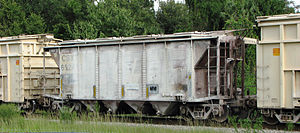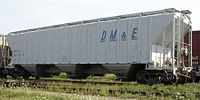AY Honors/Model Railroad/Answer Key


A covered hopper is a railroad freight car. Structurally, it is very similar to an open-top hopper car in that the carbody consists of a large hopper with unloading chutes at the bottom. What distinguishes this type of car from an open hopper is not only the car's roof, but also the car's overall size. Covered hoppers typically carry loads of less dense, and therefore lighter, materials, so they are built to a higher cubic capacity than open top hoppers. They are used predominantly to haul various grains such as corn, wheat and barley.
Grain hoppers are well designed for long term storage of grain and often retired cars are sold to farmers for use as graineries.
Some covered hoppers are built to carry loads that are heavy, but very susceptible to damage if exposed to the weather. Loads such as cement, processed phosphate, and kaolin clay are carried, in powdered form, in covered hoppers. Covered hoppers designed for these loads more closely resemble open-top hoppers.
Covered hoppers in North American service have been built by most of the freight car manufacturers of the 20th century. The most common covered hoppers that are still in use were built by either Pullman-Standard or ACF.
